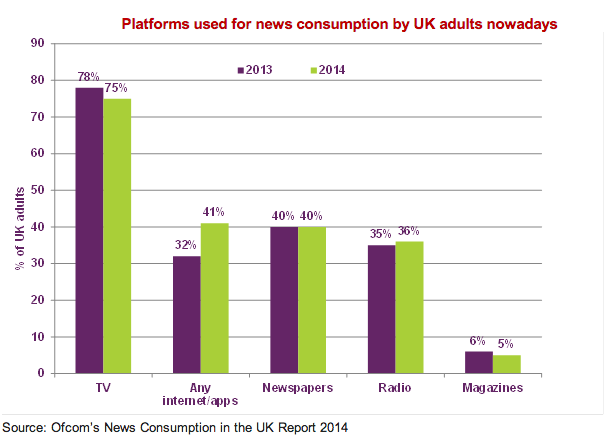Reports of the death of print have been greatly accelerated, judging by research from UK telecoms watchdog Ofcom.
The research has found that in the UK digital news, consumed via apps or websites, has only just reached parity with news consumed via ink and dead trees.
Yep those old media newspaper thingies are surprisingly sticky — and not just in the way their column inches adhere to one’s fingers.
Ofcom found that around 41% of people say they now access news on websites and apps — up significantly from around a third (32%) last year.
But despite digital news’ rising popularity, rates of newspaper usage are remaining steady overall — unchanged at four in 10 people (40%), year on year. However Ofcom’s report does note a decline in print readership “particular among the under-35s” over the past year.
Both newspapers and apps still massively trail the UK’s main source of news: the TV, although once you segment Brits by age then digital platforms come out as the primary news source for the younger age group (16 to 24).
Overall, Ofcom found that 75% of respondents identified the TV as their primary news source, down slightly from 78% in 2013. The research also notes a fall in people saying a particular TV channel is their most important source for news (down to 54% from 62% in 2013).

Ofcom says the rising popularity of digital news is being driven by increased mobile and tablet usage among younger Brits.
Some 60% of these younger Brits said they are consuming digital news in 2014, up from 44% last year. And around 45% of this age group said websites or apps are their most important sources for news, up from 30% in 2013.
The research also found that young Brits are 10x more likely than those aged 55 and over to access news on a mobile (40% vs just 4%), and twice as likely to access news via a tablet (15% vs 7%).
The converse is true when it comes to TV news — with older Brits consuming considerably more hours per year of TV news than younger Brits. Ofcom found that the over 55s watch an average of 196 hours of TV news each year vs just 27 hours for 16-24 year olds, who in turn watch 88 fewer hours of TV news than the average UK adult (115 hours a year).
The findings tally with the concept of the disintermediation of traditional news media channels as usage of on-demand digital services rises — so younger users are more likely to adopt flexible digital platforms as their primary news sources, while older generations retain more of a link to the linear media delivery pipelines they grew up with.
In terms of which digital news sources Brits are using, the most common method of accessing news online is reading news stories — up to 60% from 54% last year. While reading comments or articles on blogs or social media has decreased slightly, to 23%, from 27%, according to the findings.
Social media sites (Facebook and Twitter) are used as a news source by a fifth (20%) of online news users, while 19% said they use search engines to find news.
Overall news aggregators are used by 15% of online news users, which is down from 25% in 2013 — with Ofcom suggesting some of that drop could be attributable to the closure of Google Reader.
More specifically, the BBC website or app is most popular news source identified by online news consumers — used by 59% — followed by Google’s search engine (used by 18% for news); and then Facebook (17%) and the Sky News website or app (17%).
Ofcom’s findings are based on a survey of 2,731 people across the UK conducted in March/April of this year.
